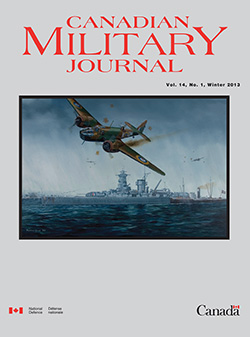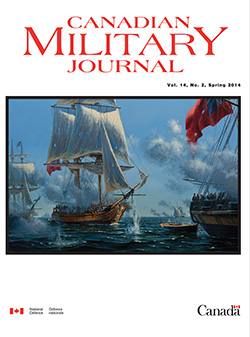LETTERS TO THE EDITOR
For more information on accessing this file, please visit our help page.

Dear Editor,
I wish to take issue with the accepted wisdom (if such a thing exists) that Canada’s defence procurement system is irretrievably broken. This narrative, recounted in Martin Shadwick’s Commentary [Vol. 14 No. 1], does not adequately apply the scientific method to justify this rather damning conclusion. While I would be the last to deny that the system has its challenges, a better scientific sample of acquisitions and a broader understanding of the issue would yield a more balanced assessment.
Consider:
- Procurement includes all contracts – not just the big ones
As the system is charged with delivering all manner of goods and services, it cannot be fairly judged by its (in)ability to see through only a select number of Major Crown Projects. Clearly, focusing upon this sub-category of procurements does not provide an adequate sample to conclude that the system is not working. Literally thousands of small- to medium-sized contracts are let every year. A system that is broken is by definition incapable of managing such a large number of diverse projects, ranging from cleaning services and spare parts, to chartered sealift and satellite imagery, to say nothing of new transport aircraft. For a military struggling to maintain broad-based capabilities, Canada doesn’t do so poorly.
One should also recall that if government policy dictates that a certain operation is a matter of national priority, the system will be (indeed, must be) directed at that mission, even if it means short-changing others. This is a matter of capacity, and it does not necessarily indicate systemic failure. Indeed, such a scenario offers the procurement system the opportunity to show what it can do in a crisis. Canada ‘moved mountains’ to satisfy urgent operational requirements in Afghanistan – so much so that our allies were literally astonished by how we were able to deliver such a wide variety of, in many cases, very sophisticated equipment to troops in the field in relatively short order.
- Many, if not most, complex projects are successful
It is ironic that while procurement ‘failure’ is newsworthy, successes often are not. One significant omission in the sample in Professor Shadwick’s column is the Halifax-class frigate life extension (HCM). This is considered an extremely complex and risky undertaking because of the many systems to be upgraded, as well as the time and budgetary constraints imposed upon the $2-billion project. And yet, all indications are that HCM is proceeding on schedule and within budget. Add to this the procurement successes of recent years (C-130J, C-17, CH-147, TAPV, Leopard 2, MilCOTS truck, AHSVS, M777 howitzer, MALE UAV, Orca-class training vessel, and so on), and one has a rather powerful rebuke to the allegation that the system cannot deliver.
- The system can ‘succeed’ even when a project ‘fails’
There seems to be no widely-accepted definition of ‘procurement failure.’ When the intention to pursue an acquisition is announced, when a project management office is stood up, there is an expectation that it will carry through to a successful conclusion (i.e. contract signing and delivery). When this doesn’t happen, when the project is knocked off course or non-delivery is the result, the charge of failure is made. But the Government of Canada or DND is free to change its mind at any time during the process – either for budgetary reasons, or as a result of a policy review or a change in government. If any of these conditions result in a stop-work order, this is not the procurement system’s fault. Indeed, the system can work perfectly – even to the point of choosing a winner in a competition (i.e. Close Combat Vehicle, EH-101 helicopter) – only to see the buyer’s priorities change. The problem of non-delivery may not, therefore, be inherent to the system itself, but rather to external factors.
- The procurement system may not have been engaged when ‘failure’ occurred
The saga of the F-35 may not, as some have suggested, have highlighted the shortcomings of the procurement system. This is because the system has arguably not yet become actively engaged in the search for a new fighter aircraft. The recommendation to proceed with a sole-source acquisition of the F-35 came from the air force, based upon a statement of operational requirement that followed rather than preceded the choice of the aircraft. Although this recommendation received high-level departmental support, those charged with carrying out the acquisition had not begun to exercise their mandates when the government set aside the recommendation. To be sure, the lines between various phases on an acquisition – i.e., options analysis and definition – may sometimes be blurred. But it seems clear that the fighter project was quite far from progressing to the implementation phase when a ‘re-think’ was ordered. Thus, the procurement system cannot be pilloried if it had not yet ‘kicked into high gear.’
- The system is the sum of its departmental parts
It is not simply DND that is accountable for (non-)delivery; Public Works and Industry Canada are part of the effort. Delays may originate from them as well as from DND. There are long-standing concerns that a lack of trained procurement staff in all departments (combined with high turn-over among military program staff) has slowed the pace of re-capitalization, resulting in DND being unable to spend its entire budget. Thus, corrective measures across several departments (not just DND) may be required. At the very least, the interplay between program budgets and the human resources required to administer them needs to be better understood.
Only time will tell if the government’s new Defence Procurement Strategy will address these issues. Improvements are sorely needed, but there are insufficient grounds for the charge of systemic failure.
David Rudd
Ottawa
Subject: Reference “A Canadian Remembrance Trail for the Centennial of the Great War?” by Pascale Marcotte, Canadian Military Journal, Vol. 14, No. 1, Winter 2013
Dear Editor,
In reference to Pascale Marcotte’s excellent article in your recent issue of the CMJ, I would like to add that at least one Canadian regiment is near completion of a similar remembrance trail. Since 2010, three former officers of the 48th Highlanders of Canada have orchestrated a memorial project in which permanent brass markers have been erected at the First World War battle sites at which the 15th Battalion, Canadian Expeditionary Force (CEF) fought. These markers describe, in both official languages, these battles, and, more specifically, the involvement of the 15th Battalion. The markers are located at many of the major CEF Battlefield locations of the day, such as 2nd Ypres, Mount Sorrel, Festubert, and Canal du Nord. A detailed article written by Brigadier-General (ret’d) Greg Young, former Commander Land Forces Central Area, can be found in the attached link to the regimental newsletter of the 48th Highlanders of Canada.
http://48highlanders.com/Downloads/Falcons/27Falcon_Winter2013.pdf
Thank you.
Cordially,
David H. Tsuchiya
Captain
Adjutant, 32 Canadian Brigade Group Headquarters

Dear CMJ,
I just wanted to give a quick thanks for including the article, “Was It Worth It? Canadian Intervention in Afghanistan and Perceptions of Success and Failure,” by Professor Sean Maloney in the Volume 14, Number 2 (Spring 2014) issue of the Canadian Military Journal. It was an ‘eye opener,’ even for myself. I have been in the military for nine years, and reading this article made me realize that even those of us in uniform are not immune to being highly influenced by the media. The article was well-written, extremely informative, and it really made me think. I am not generally a voracious reader, so I found the piece to be particularly meaningful.
Thanks again for your great work!
Greg Jones
Captain
CANSOFCOM/COMFOSCAN







